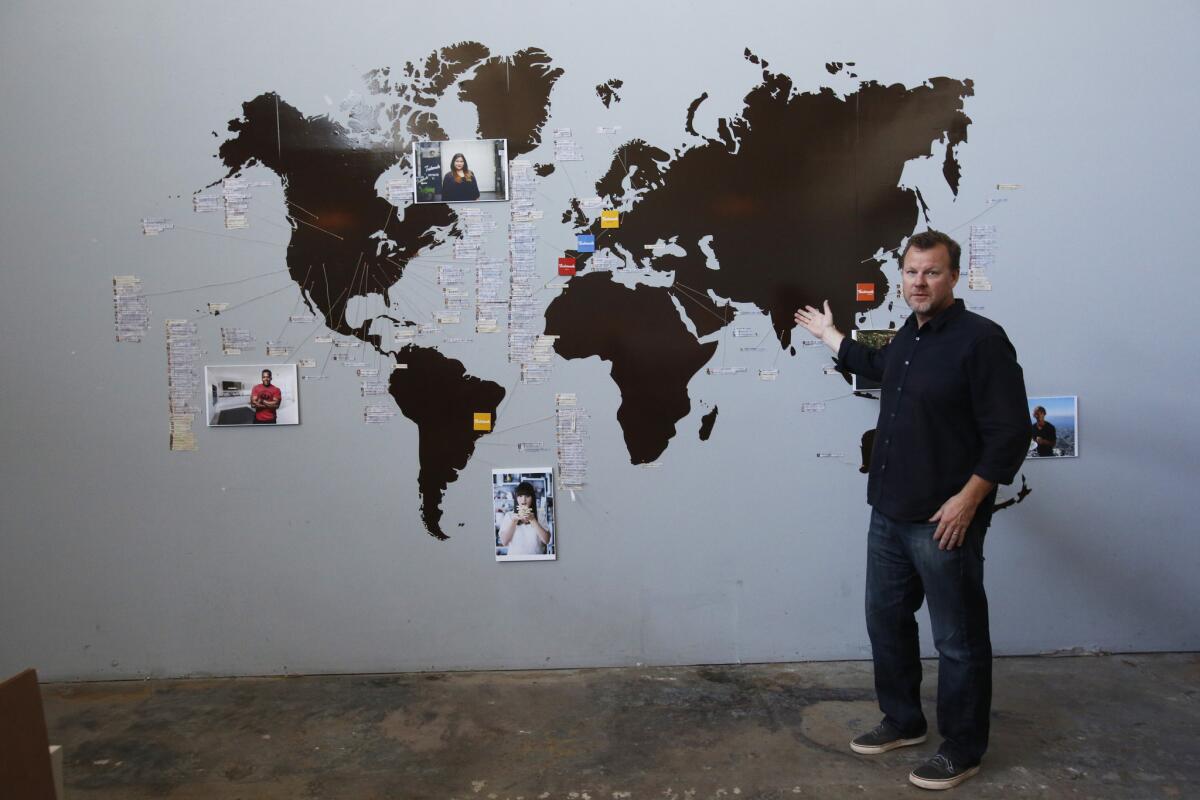As the online video world grows, content creators must cast a wide net

Julie Nolke, a cook and host on the digital food and travel channel Tastemade, had just finished filming her amped-up take on the Canadian favorite poutine — a mess of crispy fries smothered with cheese curds, bacon and gravy, spiked with beer and maple syrup.
Then it was time for the editing team to start stirring, cutting the footage different ways to get the video in front of as many eyeballs as possible — wherever they may be.

The clip had to be cropped vertically to fit mobile screens on Snapchat. Another version had to be edited down to a couple of minutes to capture fickle viewers on Facebook’s news feed. Lastly, the segment had to be distilled into a few attention-grabbing seconds to play on Twitter and Instagram.
These are the new rules of distribution in the increasingly crowded world of online video. When Tastemade launched in 2012, YouTube was mostly the only platform the so-called multi-channel network had to focus on. Now, staying ahead requires blasting your content across the dozens of video players battling for market share.
That’s why the Santa Monica media company — likened to a Food Network for the digital age — tailors its cooking demonstrations and travel adventures for Apple TV, YouTube, Facebook, Snapchat, Instagram, Spotify, Twitter, Vessel, Roku and Comcast Watchable.
By casting a wide net, Tastemade leverages rising competition in the digital video landscape to capture the broadest audience available. That’s helped the company establish itself at a time when old media is looking for key investments to stay relevant.
“This is Phase 2” of the online video industry’s development, said Peter Csathy, a streaming video expert and chief executive of Manatt Digital Media, a consulting and venture capital firm. “Multi-channel networks are becoming multi-platform networks.”
Driving it all are young viewers who are increasingly likely to watch content on their cellphones rather than a television plugged into the wall. About 75% of all Facebook videos and more than half of all YouTube videos are now viewed on mobile devices.
Advertisers are adapting accordingly. Digital video will fetch $7.8 billion in ad spending this year, up from $5.8 billion last year, according to EMarketer.
That number will double to more than $14 billion by 2019. Ad spending on TV, meanwhile, will grow about 3.5% to $81 billion over the same period, EMarketer said.
To stay abreast of the change, traditional entertainment companies such as NBCUniversal have sought to increase their digital video presence and know-how by investing in rising brands such as BuzzFeed.
Meanwhile, CNN and the Food Network are reaching millennials on Snapchat’s Discover feature, where publishers can post videos and stories each day.
“We’re in the third inning of a massive shift in dollars from TV to online video,” said Chad Gutstein, chief executive of Machinima, a digital channel similar to Tastemade but focused on video gaming and comic culture. “A tsunami of money is starting to flow.”
We’re in the third inning of a massive shift in dollars from TV to online video.
— Chad Gutstein, chief executive of Machinima
That’s led to the rapid proliferation of platforms and distributors of video, a trend not unlike the emergence of cable and satellite television networks decades earlier.
At least two of those platforms, Facebook and Snapchat, are already generating 4 billion daily video views. They’ve also introduced new products to lure advertisers and content creators. That’s raised expectations that the collection of tech giants, led by Google’s YouTube, will eventually clash.
Facebook, the biggest name to join the video gold rush, has already demonstrated how it can disrupt the industry’s YouTube-centric status quo.
The social media giant had to defuse a controversy this year over freebooting, a phenomenon in which YouTube videos were being uploaded natively onto Facebook rather than being linked back to YouTube.
That triggered anger among YouTube stars, who complained that they weren’t getting credit for views and the advertising revenue that comes with it. In response, Facebook introduced technology in August that’s aimed at identifying and ultimately stopping instances of freebooting.
Facebook’s video ambitions remain large. In July, the social media site with 1.5 billion active monthly users started experimenting with splitting ad revenue with video creators — just like YouTube does. That was followed by new features such as streaming video for celebrities, 360-degree video and word two weeks ago that it was testing a news feed exclusively for video.
“No question, Facebook is seen as a direct threat” to YouTube, Csathy of Manatt said. “But that will lead to more experimentation and more choice, which is great for the consumer.”
YouTube, which marked its 10th anniversary this year, announced an ad-free subscription service last week called YouTube Red. The service includes access to exclusive content made by some of the site’s biggest stars, such as PewDiePie and Lilly Singh.
Still, many analysts and industry officials have downplayed the competition for now, saying the space is too new to fight over while opportunities abound. Advertisers, they reason, are likely to spread their spending across platforms rather than choose just one.
“Do we think it’s bad that Facebook is potentially entering the video ecosystem? No. It’s a great thing for video overall because one company cannot build an entire industry itself,” said Jamie Byrne, Director of YouTube Creators.
“When other people enter the online video landscape, the important thing to remember is this is not a finite pie of viewership or ad dollars that we’re carving up with new entrants,” he said. “We’re incredibly early in the history of video, and it’s growing.”
The company reported in the second quarter that video ads had increased 40% from a year earlier and that average spending by its top 100 advertisers had increased 60% over the same period.
Byrne said brands like Tastemade and Machinima should distribute their shows as widely as possible to diversify revenue the same way Hollywood does with box-office receipts, television licensing and DVD sales.

TasteMade co-founder Larry Fitzgibbon shows the reach of the website in a pin map.
Doing so, he said, doesn’t change his belief that YouTube will remain the home base for the vast digital video community — a place where almost everyone got their start.
That’s certainly the case with Tastemade, whose founders saw opportunity in starting a niche network for millennials geared toward mobile video. About 60% of Tastemade’s audience is 18 to 34, many of whom are reached on Snapchat Discover.
“We started this company thinking there would be a new generation of channels that would live on digital platforms,” co-founder Larry Fitzgibbon said. “And someone would need to create them and build a brand around them. What’s exciting for us is that we’re starting to see that come together.”
YouTube has been at the core of their strategy. Tastemade has curated over 5,000 hours of licensed video made by amateur talent discovered on the massive video site. A sprawling map painted onto the wall of the company’s headquarters illustrates with head shots and names exactly where the channel’s 1,000 contributors are around the globe.
“It’s like having a studio in the cloud,” said Fitzgibbon, who is one of three co-founders at the company.
(Tastemade has yet to make a profit but has raised more than $40 million through investors, including Scripps Networks, owner of the Food Network and the Cooking Channel).

Tastemade also produces dozens of original shows such as “Raw. Vegan. Not Gross” and “Thirsty For,” which demonstrates how to make drinks from various countries. The program is shot deliberately to show only the ingredients and drink preparer’s hands. No words are spoken. The recipe is displayed across the screen in text, which can be translated into several languages depending on which market the show is targeting.
That’s a winning formula for Facebook, which is where Tastemade garners one of its widest international audiences. As much as Tastemade is still anchored to YouTube, it is on Facebook that the company has experienced some of the most dramatic changes.
Tastemade was selected to participate in Facebook’s new ad revenue sharing model, and it was invited to work with Facebook Anthology, an advertising program that partners content creators with Facebook’s creative department to produce content for brands.
Tastemade’s Facebook page has gone from a few hundred thousand “likes” in 2014 to more than 3.7 million and counting. The upswing has been helped by a steady flow of new content to the page, which is uploaded natively rather than sitting on YouTube’s servers. After that, Tastemade can sit back and watch Facebook’s algorithm and users fan its content around the world.
“Facebook is set up for sharing,” Fitzgibbon said. “People aren’t just watching our content; they’re deeply engaging with it. And that’s a unique aspect of their platform. All these different platforms have something unique going for them.”
Twitter: @dhpierson







